Salva Rühling Cachay
Probabilistic Emulation of a Global Climate Model with Spherical DYffusion
Jun 21, 2024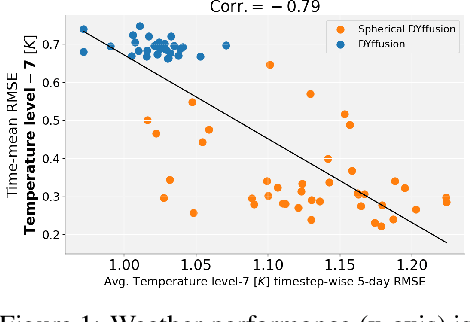
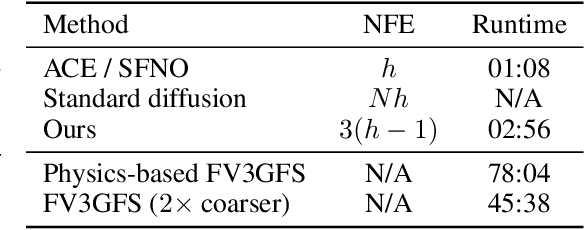

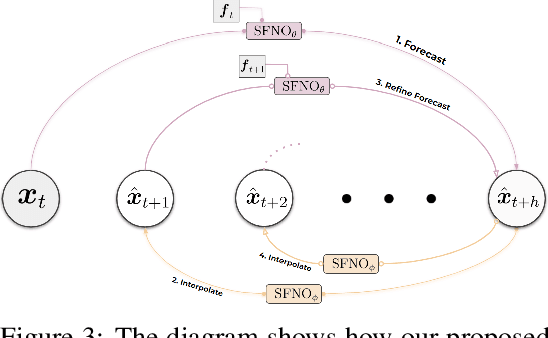
Abstract:Data-driven deep learning models are on the verge of transforming global weather forecasting. It is an open question if this success can extend to climate modeling, where long inference rollouts and data complexity pose significant challenges. Here, we present the first conditional generative model able to produce global climate ensemble simulations that are accurate and physically consistent. Our model runs at 6-hourly time steps and is shown to be stable for 10-year-long simulations. Our approach beats relevant baselines and nearly reaches a gold standard for successful climate model emulation. We discuss the key design choices behind our dynamics-informed diffusion model-based approach which enables this significant step towards efficient, data-driven climate simulations that can help us better understand the Earth and adapt to a changing climate.
DYffusion: A Dynamics-informed Diffusion Model for Spatiotemporal Forecasting
Jun 03, 2023Abstract:While diffusion models can successfully generate data and make predictions, they are predominantly designed for static images. We propose an approach for training diffusion models for dynamics forecasting that leverages the temporal dynamics encoded in the data, directly coupling it with the diffusion steps in the network. We train a stochastic, time-conditioned interpolator and a backbone forecaster network that mimic the forward and reverse processes of conventional diffusion models, respectively. This design choice naturally encodes multi-step and long-range forecasting capabilities, allowing for highly flexible, continuous-time sampling trajectories and the ability to trade-off performance with accelerated sampling at inference time. In addition, the dynamics-informed diffusion process imposes a strong inductive bias, allowing for improved computational efficiency compared to traditional Gaussian noise-based diffusion models. Our approach performs competitively on probabilistic skill score metrics in complex dynamics forecasting of sea surface temperatures, Navier-Stokes flows, and spring mesh systems.
Climate Intervention Analysis using AI Model Guided by Statistical Physics Principles
Feb 07, 2023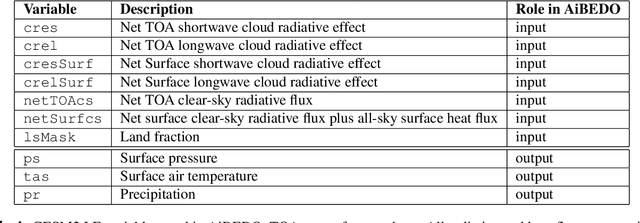
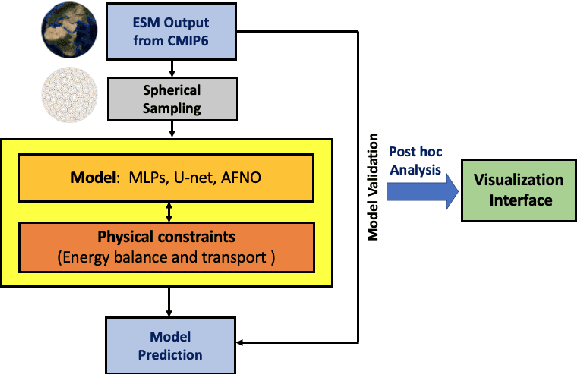
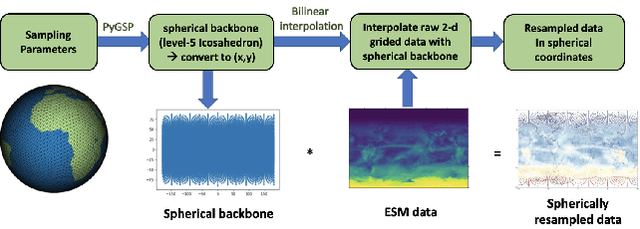

Abstract:The availability of training data remains a significant obstacle for the implementation of machine learning in scientific applications. In particular, estimating how a system might respond to external forcings or perturbations requires specialized labeled data or targeted simulations, which may be computationally intensive to generate at scale. In this study, we propose a novel solution to this challenge by utilizing a principle from statistical physics known as the Fluctuation-Dissipation Theorem (FDT) to discover knowledge using an AI model that can rapidly produce scenarios for different external forcings. By leveraging FDT, we are able to extract information encoded in a large dataset produced by Earth System Models, which includes 8250 years of internal climate fluctuations, to estimate the climate system's response to forcings. Our model, AiBEDO, is capable of capturing the complex, multi-timescale effects of radiation perturbations on global and regional surface climate, allowing for a substantial acceleration of the exploration of the impacts of spatially-heterogenous climate forcers. To demonstrate the utility of AiBEDO, we use the example of a climate intervention technique called Marine Cloud Brightening, with the ultimate goal of optimizing the spatial pattern of cloud brightening to achieve regional climate targets and prevent known climate tipping points. While we showcase the effectiveness of our approach in the context of climate science, it is generally applicable to other scientific disciplines that are limited by the extensive computational demands of domain simulation models. Source code of AiBEDO framework is made available at https://github.com/kramea/kdd_aibedo. A sample dataset is made available at https://doi.org/10.5281/zenodo.7597027. Additional data available upon request.
ClimART: A Benchmark Dataset for Emulating Atmospheric Radiative Transfer in Weather and Climate Models
Nov 29, 2021



Abstract:Numerical simulations of Earth's weather and climate require substantial amounts of computation. This has led to a growing interest in replacing subroutines that explicitly compute physical processes with approximate machine learning (ML) methods that are fast at inference time. Within weather and climate models, atmospheric radiative transfer (RT) calculations are especially expensive. This has made them a popular target for neural network-based emulators. However, prior work is hard to compare due to the lack of a comprehensive dataset and standardized best practices for ML benchmarking. To fill this gap, we build a large dataset, ClimART, with more than \emph{10 million samples from present, pre-industrial, and future climate conditions}, based on the Canadian Earth System Model. ClimART poses several methodological challenges for the ML community, such as multiple out-of-distribution test sets, underlying domain physics, and a trade-off between accuracy and inference speed. We also present several novel baselines that indicate shortcomings of datasets and network architectures used in prior work. Download instructions, baselines, and code are available at: https://github.com/RolnickLab/climart
End-to-End Weak Supervision
Jul 05, 2021



Abstract:Aggregating multiple sources of weak supervision (WS) can ease the data-labeling bottleneck prevalent in many machine learning applications, by replacing the tedious manual collection of ground truth labels. Current state of the art approaches that do not use any labeled training data, however, require two separate modeling steps: Learning a probabilistic latent variable model based on the WS sources -- making assumptions that rarely hold in practice -- followed by downstream model training. Importantly, the first step of modeling does not consider the performance of the downstream model. To address these caveats we propose an end-to-end approach for directly learning the downstream model by maximizing its agreement with probabilistic labels generated by reparameterizing previous probabilistic posteriors with a neural network. Our results show improved performance over prior work in terms of end model performance on downstream test sets, as well as in terms of improved robustness to dependencies among weak supervision sources.
Dependency Structure Misspecification in Multi-Source Weak Supervision Models
Jun 18, 2021

Abstract:Data programming (DP) has proven to be an attractive alternative to costly hand-labeling of data. In DP, users encode domain knowledge into \emph{labeling functions} (LF), heuristics that label a subset of the data noisily and may have complex dependencies. A label model is then fit to the LFs to produce an estimate of the unknown class label. The effects of label model misspecification on test set performance of a downstream classifier are understudied. This presents a serious awareness gap to practitioners, in particular since the dependency structure among LFs is frequently ignored in field applications of DP. We analyse modeling errors due to structure over-specification. We derive novel theoretical bounds on the modeling error and empirically show that this error can be substantial, even when modeling a seemingly sensible structure.
The World as a Graph: Improving El Niño Forecasts with Graph Neural Networks
Apr 11, 2021



Abstract:Deep learning-based models have recently outperformed state-of-the-art seasonal forecasting models, such as for predicting El Ni\~no-Southern Oscillation (ENSO). However, current deep learning models are based on convolutional neural networks which are difficult to interpret and can fail to model large-scale atmospheric patterns. In comparison, graph neural networks (GNNs) are capable of modeling large-scale spatial dependencies and are more interpretable due to the explicit modeling of information flow through edge connections. We propose the first application of graph neural networks to seasonal forecasting. We design a novel graph connectivity learning module that enables our GNN model to learn large-scale spatial interactions jointly with the actual ENSO forecasting task. Our model, \graphino, outperforms state-of-the-art deep learning-based models for forecasts up to six months ahead. Additionally, we show that our model is more interpretable as it learns sensible connectivity structures that correlate with the ENSO anomaly pattern.
Graph Neural Networks for Improved El Niño Forecasting
Dec 10, 2020

Abstract:Deep learning-based models have recently outperformed state-of-the-art seasonal forecasting models, such as for predicting El Ni\~no-Southern Oscillation (ENSO). However, current deep learning models are based on convolutional neural networks which are difficult to interpret and can fail to model large-scale atmospheric patterns called teleconnections. Hence, we propose the application of spatiotemporal Graph Neural Networks (GNN) to forecast ENSO at long lead times, finer granularity and improved predictive skill than current state-of-the-art methods. The explicit modeling of information flow via edges may also allow for more interpretable forecasts. Preliminary results are promising and outperform state-of-the art systems for projections 1 and 3 months ahead.
 Add to Chrome
Add to Chrome Add to Firefox
Add to Firefox Add to Edge
Add to Edge